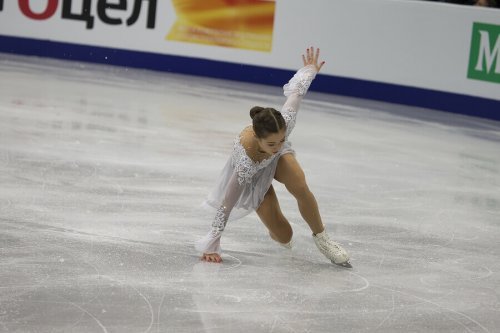The Most Common Injuries in Figure Skating

There are many common injuries in figure skating. Skaters perform jumps, pirouettes, turns, and step sequences that can cause injuries that are quite serious and detrimental to their well-being. It’s a sport with a high degree of technical difficulty in which you have to know how to move quickly and agilely. Having a good sense of space and sufficient resistance is also necessary.
For this reason, the skaters must be constantly training to stay in shape and be able to execute all these skills. Although, exhaustion from the training and the dangerous maneuvers can result in stiffness, injury, or trauma.
That’s why it’s important for the athletes to be careful and aware of any discomfort, in addition to doing everything possible to prevent injuries. Up next, we’ll show you the most common injuries in figure skating.
Common injuries in figure skating
1. Ankle sprains and fractures
The skates, jumps, weight, and pressure exerted on the ankles make the skaters susceptible to sprains and fractures. Figure skating injuries in the ankle caused by stress may include damage to the peroneal and anterior tibial muscles.
Additionally, these afflictions are extremely intricate for athletes since it directly affects their performance on the skating rink. A strong ankle injury could even harm a person’s sports career.

2. Knee injuries are one of the common injuries in figure skating
Knee injuries can occur in a fall due to muscle exhaustion or mistakes while performing a technique. Falls usually result in minor injuries that leave the skater with a sore knee and a bruise.
Nonetheless, a strong blow can seriously damage the kneecap or even dislocate it. If not corrected with physiotherapy, misalignment of the patella can cause progressive damage to the knee and cartilage that keeps it stable.
The knees can also suffer an injury from the torsional force that jumps or turns generate. Generally, such injuries involve the ligaments that correctly position the knee joint.
3. Common injuries in figure skating: tendinitis
The skates protect a skater’s feet because they’re designed to safeguard them as best as possible. However, repeatedly applying force in each step can cause tendonitis.
Tendonitis can occur in the Achilles tendon, the ankle, or in the lower part of the foot, among other areas. Therefore, skaters must wear the right shoes and pay attention to the well-being of their feet.
4. Injuries in the hands and wrists
When experiencing a slip or fall, our immediate instinct is to reach out to protect ourselves. This is good, as it serves to guard the face. Nevertheless, it can also cause serious injuries to the hands or wrists due to the force of impact.
5. Head wounds
In the event of a loss of balance or control, head injuries are a common and also serious consequence. The surface of the ice is very dangerous since there’s no cushioning against the impact. These skating injuries can cause concussions or other traumatic results.
Injury prevention
In figure skating, you must do everything possible to avoid an injury. The main reason is that it can cause problems at a muscular level and it can also hinder the progress of an athlete’s career. Hence, there are a few measures that must be put into practice in order to prevent any damage:
- Always warm-up very well before entering the ice rink.
- Make sure you have the physical ability and all the skills to execute the different moves and spins.
- Wear the proper clothing for skating: no jewelry, avoid loose clothing, tie your hair, and proper-sized skates.

- If possible, don’t train while you’re exhausted or injured. This could worsen your physical and mental state as well as affect your performance.
- Have a kit at hand with the basic supplies to deal with wounds, such as adhesive bandages, alcohol, cotton, povidone, ointment for blows, muscle gel, etc.
- Go to a specialist when you feel pain, discomfort, or if you suspect an injury. In all cases, avoid self-medication.
In short, ice skating is a sport that demands grit but is delicate and full of elegance as well. Therefore, it’s necessary to be very strict when executing the moves since suffering any of these injuries wouldn’t be convenient at all.
There are many common injuries in figure skating. Skaters perform jumps, pirouettes, turns, and step sequences that can cause injuries that are quite serious and detrimental to their well-being. It’s a sport with a high degree of technical difficulty in which you have to know how to move quickly and agilely. Having a good sense of space and sufficient resistance is also necessary.
For this reason, the skaters must be constantly training to stay in shape and be able to execute all these skills. Although, exhaustion from the training and the dangerous maneuvers can result in stiffness, injury, or trauma.
That’s why it’s important for the athletes to be careful and aware of any discomfort, in addition to doing everything possible to prevent injuries. Up next, we’ll show you the most common injuries in figure skating.
Common injuries in figure skating
1. Ankle sprains and fractures
The skates, jumps, weight, and pressure exerted on the ankles make the skaters susceptible to sprains and fractures. Figure skating injuries in the ankle caused by stress may include damage to the peroneal and anterior tibial muscles.
Additionally, these afflictions are extremely intricate for athletes since it directly affects their performance on the skating rink. A strong ankle injury could even harm a person’s sports career.

2. Knee injuries are one of the common injuries in figure skating
Knee injuries can occur in a fall due to muscle exhaustion or mistakes while performing a technique. Falls usually result in minor injuries that leave the skater with a sore knee and a bruise.
Nonetheless, a strong blow can seriously damage the kneecap or even dislocate it. If not corrected with physiotherapy, misalignment of the patella can cause progressive damage to the knee and cartilage that keeps it stable.
The knees can also suffer an injury from the torsional force that jumps or turns generate. Generally, such injuries involve the ligaments that correctly position the knee joint.
3. Common injuries in figure skating: tendinitis
The skates protect a skater’s feet because they’re designed to safeguard them as best as possible. However, repeatedly applying force in each step can cause tendonitis.
Tendonitis can occur in the Achilles tendon, the ankle, or in the lower part of the foot, among other areas. Therefore, skaters must wear the right shoes and pay attention to the well-being of their feet.
4. Injuries in the hands and wrists
When experiencing a slip or fall, our immediate instinct is to reach out to protect ourselves. This is good, as it serves to guard the face. Nevertheless, it can also cause serious injuries to the hands or wrists due to the force of impact.
5. Head wounds
In the event of a loss of balance or control, head injuries are a common and also serious consequence. The surface of the ice is very dangerous since there’s no cushioning against the impact. These skating injuries can cause concussions or other traumatic results.
Injury prevention
In figure skating, you must do everything possible to avoid an injury. The main reason is that it can cause problems at a muscular level and it can also hinder the progress of an athlete’s career. Hence, there are a few measures that must be put into practice in order to prevent any damage:
- Always warm-up very well before entering the ice rink.
- Make sure you have the physical ability and all the skills to execute the different moves and spins.
- Wear the proper clothing for skating: no jewelry, avoid loose clothing, tie your hair, and proper-sized skates.

- If possible, don’t train while you’re exhausted or injured. This could worsen your physical and mental state as well as affect your performance.
- Have a kit at hand with the basic supplies to deal with wounds, such as adhesive bandages, alcohol, cotton, povidone, ointment for blows, muscle gel, etc.
- Go to a specialist when you feel pain, discomfort, or if you suspect an injury. In all cases, avoid self-medication.
In short, ice skating is a sport that demands grit but is delicate and full of elegance as well. Therefore, it’s necessary to be very strict when executing the moves since suffering any of these injuries wouldn’t be convenient at all.
All cited sources were thoroughly reviewed by our team to ensure their quality, reliability, currency, and validity. The bibliography of this article was considered reliable and of academic or scientific accuracy.
- Campanelli, V., Piscitelli, F., Verardi, L., Maillard, P., & Sbarbati, A. (2015). Lower Extremity Overuse Conditions Affecting Figure Skaters During Daily Training. Orthopaedic Journal of Sports Medicine, 3(7).
- Okamura, S., Wada, N., Tazawa, M., Sohmiya, M., Ibe, Y., Shimizu, T., … Shirakura, K. (2014). Injuries and disorders among young ice skaters : relationship with generalized joint laxity and tightness. Open Access Journal of Sports Medicine, 191–195.
- Porter, E. B., Young, C. C., Niedfeldt, M. W., & Gottschlich, L. M. (2007). Sport-Specific Injuries and Medical Problems of Figure Skaters. WMJ : Official Publication of the State Medical Society of Wisconsin, 106(6), 330–334. Retrieved from papers://6c494451-ee6e-4dd0-9f2c-10e1a6a49c65/Paper/p50
- Ferrara, C. M., & Hollingsworth, E. (2007). Physical characteristics and incidence of injuries in adult figure skaters. International Journal of Sports Physiology and Performance, 2(3), 282–291. https://doi.org/10.1123/ijspp.2.3.282
- Porter, E. B. (2013). Common injuries and medical problems in singles figure skaters. Current Sports Medicine Reports, 12(5), 318–320. https://doi.org/10.1249/JSR.0b013e3182a4b94e
This text is provided for informational purposes only and does not replace consultation with a professional. If in doubt, consult your specialist.








